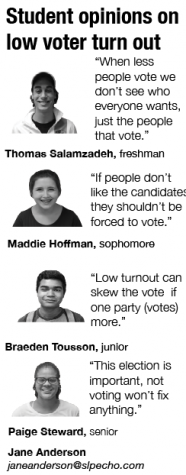Polling system unfairly inaccessible
Discriminatory process limits voter turnout
November 8, 2016
A merican voting regulations suppress many citizens’ right to voice their political opinions by complicating the polling process.
merican voting regulations suppress many citizens’ right to voice their political opinions by complicating the polling process.
According to the United States Elections Project, the 2014 midterm election experienced the lowest voter turnout since the 1942 midterm. Both midterm elections showed record low numbers of just 36.4 percent. Almost two thirds of eligible voters didn’t vote.
According to a study by Bloomberg Politics, many eligible voters who don’t vote claim they’re too busy. Some say they can’t get to the polls, they don’t have time to register or the polls are too full. Problems like these shouldn’t get in the way of people voting for their leaders. Many people point to mandatory voting as a solution to low turnout. Although it would increase turnout, mandatory voting wouldn’t fit with the United States principles. The more viable solution to low voter turnout is to change the voting laws to fit citizens’ needs and end voter discrimination so all American citizens can vote more easily.
Although any citizen 18 years or older without a felony in the United States has the right to vote, voter discrimination still takes place in the United States. The 2013 Voter Information Verification Act passed in North Carolina required voters to show identification before voting and shortened the amount of early voting time. The two requirements were diffcult for African Americans and other minorities to meet, so their poll numbers were far lower than whites.
Voter discrimination shouldn’t exist at this point of development in the United States, and it only sets our country back. The Voting Rights Act was passed in 1965 to end voter discrimination, so there is no reason for voter discrimination to still be present today.
If the United States wants to see a higher voter turnout, ending voter discrimination would help by making it less difficult for minorities to register and vote.
Removing the registration system for people who are already citizens would increase voter turnout because the registration system is tedious. Switching to a voting system that provides more time and doesn’t involve registration would benefit the United States the most.
Sweden, for example, has no registration and has a national holiday for voting.
During the day, polls are open for voters to come in and out, rather than the polls being full after a work day. Sweden also doesn’t have required registration and any citizen from the European Union can vote there. Polls show Sweden’s voter turnout in 2014 was 85.8 percent, over twice that of the United States.
Voter discrimination, registration and the small voting period are all factors that contribute to America’s low voter turnout. If the United States were to adopt a system like Sweden’s, the country would have a much higher turnout and wouldn’t have to change its rights.



